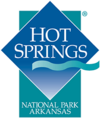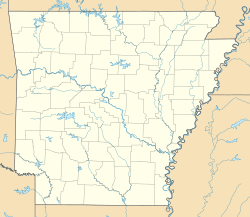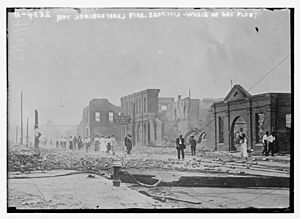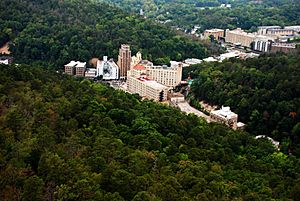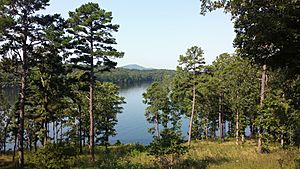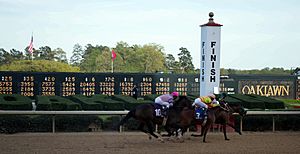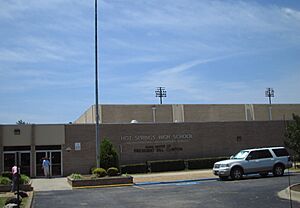Hot Springs, Arkansas facts for kids
Quick facts for kids
Hot Springs, Arkansas
|
|||
|---|---|---|---|
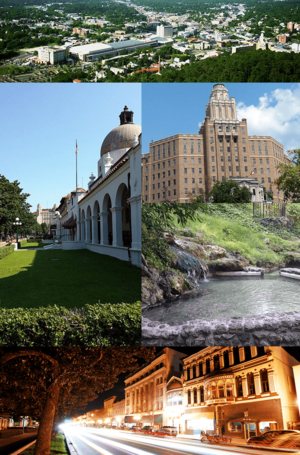
Clockwise from top: Aerial view of Hot Springs, Army-Navy Hospital, a pool of hot spring water in Hot Springs National Park, the Central Avenue Historic District, Bathhouse Row
|
|||
|
|||
| Nickname(s):
Valley of the Vapors, Spa City
|
|||
| Motto(s):
"America's First Resort"
|
|||

Location of Hot Springs in Garland County, Arkansas
|
|||
| Country | |||
| State | |||
| County | Garland | ||
| Incorporated | January 10, 1851 | ||
| Government | |||
| • Type | Council-manager | ||
| Area | |||
| • City | 37.57 sq mi (97.31 km2) | ||
| • Land | 37.45 sq mi (97.00 km2) | ||
| • Water | 0.12 sq mi (0.31 km2) | ||
| Elevation | 568 ft (173 m) | ||
| Population
(2020)
|
|||
| • City | 37,930 | ||
| • Density | 1,012.79/sq mi (391.04/km2) | ||
| • Metro | 100,180 | ||
| Time zone | UTC−6 (Central (CST)) | ||
| • Summer (DST) | UTC−5 (CDT) | ||
| ZIP code |
71901-03, 71913-14
|
||
| Area code(s) | 501 | ||
| FIPS code | 05-33400 | ||
| GNIS feature ID | 2404733 | ||
Hot Springs is a fun resort city in Arkansas. It's the main city of Garland County. The city is nestled in the Ouachita Mountains and is famous for its many natural hot springs. That's how it got its name! In 2020, about 37,930 people lived here, making it the eleventh-largest city in Arkansas.
The heart of Hot Springs is the oldest protected area by the United States government. Today, it's known as Hot Springs National Park. For hundreds of years, people believed the hot spring water had special healing powers. Native American tribes also shared legends about these springs. After the government protected the area in 1832, Hot Springs grew into a popular spa town. The city was officially formed on January 10, 1851. It has a rich history, including Major League Baseball spring training, horse racing at Oaklawn Park, and even visits from famous people like Al Capone and former President Bill Clinton. A large Christian group, the Assemblies of God, also started here.
Many parts of Hot Springs' history are kept safe by different groups. Hot Springs National Park is looked after by the National Park Service. This includes Bathhouse Row, which has eight old bathhouse buildings and gardens. Downtown Hot Springs is also a protected area called the Central Avenue Historic District. It's listed on the National Register of Historic Places. The city also has many historic hotels and motels. These were built during the Great Depression in a cool style called Art Deco. Because the hot waters were so popular, Hot Springs grew fast when many other cities were struggling. This makes Hot Springs' buildings a special mix of cultures. The city is also a great place for arts, with festivals like the Hot Springs Music Festival and the Hot Springs Documentary Film Festival.
Contents
History
Early Settlement
For a very long time, many Native American tribes came to this valley. They believed the warm springs had healing powers.
In 1673, explorers from France, Father Marquette and Jolliet, explored the area. They claimed the land for France. Later, in 1763, the land was given to Spain. But in 1800, France got it back. Then, in 1803, the United States bought it as part of the Louisiana Purchase.
In 1804, George Hunter and William Dunbar explored the springs. They found a simple log cabin and shelters used by people seeking healing. In 1807, a man named Prudhomme became the first modern settler in Hot Springs. Soon, John Perciful and Isaac Cates joined him.
On August 24, 1818, the Quapaw Native Americans gave the land around the hot springs to the United States. In 1820, after Arkansas became a territory, its leaders asked for the springs to be protected. Twelve years later, in 1832, the United States Congress created the Hot Springs Reservation. This protected the special thermal waters. The reservation was renamed Hot Springs National Park in 1921.
Civil War Era
When the American Civil War began, fewer people came to Hot Springs for baths. After the Confederate army lost a battle in March 1862, the Union troops moved towards Little Rock. The Confederate Governor, Henry M. Rector, moved his staff and state records to Hot Springs. However, Union forces did not attack Little Rock, and the government returned on July 14, 1862.
Many Hot Springs residents left for Texas or Louisiana until the war ended. In September 1863, Union forces took over Little Rock. During this time, Hot Springs was attacked by small groups of fighters. These groups were loosely connected to either the Union or Confederate sides. They robbed and burned the nearly empty town. Only a few buildings were left after the Civil War.
Rebuilding and Growth
After the Civil War, many new bathhouses and hotels were built in Hot Springs. The number of people living there all year grew to 1,200 by 1870. By 1873, there were six bathhouses and 24 hotels near the springs.
In 1873, Hot Springs became the main city for the new Garland County. Before that, it was part of Hot Spring County.
In 1874, Joseph Reynolds decided to build a narrow-gauge railroad from Malvern to Hot Springs. When it was finished in 1875, more visitors came to the springs. Samuel W. Fordyce and two other business people helped pay for the first fancy hotel, the Arlington Hotel. It opened in 1875.
After the Civil War, there were many arguments over who owned the land. On April 24, 1876, the Supreme Court decided that the land in Hot Springs belonged to the federal government. People protested this decision. To fix the problem, Congress created the Hot Springs Commission. This group planned the streets, settled land claims, and decided which buildings were on government land. They also set up a way for people to buy land. The commission set aside about 265 acres for the hot springs and Hot Springs Mountain. This area became a permanent government reservation. Another 1,200 acres became the town of Hot Springs. About 700 acres were given to people who had claimed land. The town had 196 blocks and 50 miles of streets. The rest of the original government land was mostly hills and mountains. In June 1880, Congress added these lands to the permanent reservation.
Baseball in Hot Springs
Hot Springs has a very interesting baseball history. In the early 1900s, it was famous for baseball training camps. Many people call it the "birthplace" of Spring training baseball. The first Major League Baseball team to come here was the Chicago White Stockings (now the Chicago Cubs) in 1886. They brought their coaches and players to get ready for the season.
Albert Spalding, who owned the Chicago White Stockings, and player/manager Cap Anson started the idea of players training before the season. This is why Hot Springs is called the "birthplace of spring training baseball." Both Spalding and Anson liked the city and its natural springs for their players. They first played at the Hot Springs Baseball Grounds. Many other teams soon followed Chicago and came to Hot Springs to train.
Teams like the Cleveland Spiders, Pittsburgh Pirates, Brooklyn Dodgers, Chicago Cubs, Cincinnati Reds, Detroit Tigers, New York Yankees, St. Louis Cardinals, and Boston Red Sox all trained in Hot Springs. To have more places for teams to play, Whittington Park was built in 1894. Then came Majestic Park in 1908 and Fogel Field in 1912. It's known that 134 members of the Baseball Hall of Fame trained or played in Hot Springs.
Negro league baseball teams also used Hot Springs for spring training. The Pittsburgh Crawfords trained at Fogel Field from 1932 to 1935. Their team included Hall of Fame players like Cool Papa Bell, Josh Gibson, Oscar Charleston, and Judy Johnson. The Homestead Grays trained at Fogel Field in 1930 and 1931. They also had many Hall of Fame players, including Cool Papa Bell, Josh Gibson, Oscar Charleston, and Willie Wells.
March 17, 1918, is called the "Day that changed Baseball Forever." On that day, Boston Red Sox pitcher Babe Ruth hit a very long home run. It landed in the Arkansas Alligator Farm and Petting Zoo. This changed baseball history. In an exhibition game against Brooklyn at Whittington Park, Ruth was a last-minute player at first base. It was his first time playing a position other than pitcher. Ruth hit two long home runs that day. His second home run was incredibly long, estimated at 573 feet!
After that day, Ruth became a hitter, not just a pitcher. In Hot Springs, Ruth was often seen walking around, visiting the bath spas, and going to the horse track. There's a plaque for Ruth at the Alligator Farm and a marker at the old Whittington Park.
The Pittsburgh Pirates trained at Whittington Park for over ten years. Hall of Fame shortstop Honus Wagner became a well-known person in the city. In 1912, Wagner bought and gave basketball uniforms and equipment to Hot Springs High School. The uniforms were black and gold, like the Pirates' colors. The high school then permanently changed its colors to black and gold. Wagner also refereed a basketball game for the school that season.
In 1952, 18-year-old Hank Aaron played in the Negro American League championship. He played for the Indianapolis Clowns against the Birmingham Black Barons at Majestic Park.
On October 22, 1953, Jackie Robinson played an exhibition game at Majestic Park. Robinson had broken Major League Baseball's color barrier in 1947. His team played the Negro American League All-Stars that day.
The First Boys of Spring is a 2015 documentary about Hot Springs Baseball spring training. The film shows many historical items from Hot Springs. It was made by Arkansas filmmaker Larry Foley and is narrated by actor Billy Bob Thornton, who is from the Hot Springs area. The documentary first aired nationally on the MLB Network in February 2016.
Today, you can follow the Hot Springs Baseball Historic Trail. There are 26 green markers around Hot Springs that point out important people and places. There's also an app to give you more information.
The 1913 Fire
On September 5, 1913, a big fire started on Church Street. It was a few blocks from Bathhouse Row. The fire first spread away from the hospital. But then the wind changed direction. The fire quickly moved towards the business area. It destroyed the Ozark Sanitarium and Hot Springs High School. It also burned the Public Utilities plant, which cut off the firefighters' water supply.
A wide part of the fire then blew towards Ouachita Avenue. It destroyed the Garland County Court House. The Hot Springs Fire Department fought the fire with help from the Little Rock Fire Department. They had rushed over on a special train. Despite their efforts, many homes, about a hundred businesses, four hotels, and the Crystal Theater were destroyed. A rainstorm finally put out the fire at Hazel Street. Central Avenue was saved, mostly by using dynamite. But much of the southern part of the city was destroyed. The damage was estimated at $10,000,000 across 60 blocks.
Assemblies of God Begins
From April 2 to April 12, 1914, many Christian leaders met in Hot Springs. They came together to form a new group called the Assemblies of God. This group has grown to be one of the largest Christian denominations in the United States. As of 2014, it had over 3 million members, nearly 13,000 churches, and almost 37,000 ministers.
Gambling in Hot Springs
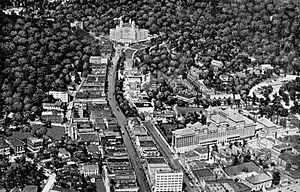
Illegal gambling became very popular in Hot Springs after the Civil War. Two groups, the Flynns and the Dorans, fought for control in the 1880s. Frank Flynn, the leader of the Flynn group, paid local police and sheriff's officers. They helped him collect debts and scare his gambling rivals. This led to a gunfight on March 16, 1899.
The Arlington Hotel is a famous landmark in downtown Hot Springs. It was a favorite place for people like Al Capone.
Hot Springs became a national center for gambling. Owney Madden and his Hotel Arkansas casino were very important. From 1927 to 1947, gambling was at its peak. There were at least ten large casinos and many smaller ones operating openly. It was the biggest such operation in the United States at the time. Hotels even advertised the availability of certain services. You could also bet on almost any horse race in North America.
Local law enforcement was controlled by a powerful political group led by Mayor Leo McLaughlin. This group bought many poll tax receipts, some in the names of people who had passed away or were not real. These were sometimes used to vote in different areas. A former sheriff who tried to stop illegal gambling and make elections fair was killed in 1937.
The political group's control of the city ended in 1946. A group of World War II veterans, led by Marine Lt. Col. Sid McMath, was elected. McMath became the prosecuting attorney. In 1947, a grand jury accused several casino owners and Mayor McLaughlin of bribing public officials. Even though McLaughlin and most others were found not guilty, the political group's power was broken. Gambling stopped for a while. McMath then led a statewide movement and became governor in 1948.
However, illegal casino gambling started again when Orval Faubus became governor in 1954. Faubus was popular for not following federal court orders about desegregation. He allowed gambling to continue in Hot Springs. A magazine called Variety explained in 1959 that casinos operated by paying a weekly fine in local court.
Gambling was finally shut down in 1967 by two Republican leaders: Governor Winthrop Rockefeller and Judge Henry M. Britt. Rockefeller sent state troopers to close the casinos and burn their gambling equipment. For many years, Oaklawn Park, a horse racing track, was the only legal gambling place in Hot Springs. It was one of only two in Arkansas. Oaklawn is still open today.
After the Civil War, people wanted to build an Army-Navy hospital in Hot Springs. A former Navy surgeon, A.S. Garnett, and a retired Union general, John A. Logan, pushed for this idea. In 1884, Logan convinced Congress to set aside $100,000 for the hospital. The first hospital had 100 beds and was built in a style that required patients to walk long distances.
After World War I, Congress gave $1.5 million to build a new hospital. This new building could hold 500 patients. It had modern features like an X-ray wing and a temperature-controlled morgue. Its operating rooms were considered the best in the country.
During World War II, the hospital became too crowded. The Army and Navy sent some patients to nearby hotels like the Arlington and Majestic. The hospital also trained dentists, surgeons, and pharmacists. It had the first school for medical technicians in the Women's Army Corps. Famous people like Helen Keller and Joe DiMaggio were treated here. The hospital closed on April 1, 1960, likely because fewer people needed it. The land was sold to Arkansas for one dollar.
World War II and Hot Springs
In 1942, the military took over the large Eastman Hotel. This was because the Army and Navy Hospital was not big enough for all the sick and wounded soldiers. In 1944, the Army needed a place to process soldiers returning from overseas. After looking at hotels in 20 cities, they chose Hot Springs.
In August 1944, the Army took over most of the hotels in Hot Springs. Soldiers from the west-central states got a 21-day break. Then, they spent 14 days updating their military records and getting medical and dental care. The soldiers also had time to enjoy the baths at a lower price and do other fun activities. The center closed in December 1945. It had processed over 32,000 military members. In 1946, after the war, the Eastman Hotel was torn down because the government no longer needed it.
Hot Springs Today
In 2013, Forbes magazine named the Hot Springs area one of the best "small places for business and careers." They noted its low business costs, good job growth, and skilled workers.
Geography
Hot Springs is in the southeastern part of Garland County. It's on the edge of the Ouachita Mountains. The city is about 55 miles southwest of Little Rock.
The city of Hot Springs covers about 35.1 square miles. Most of this is land, and a small part is water.
Natural Springs
The city gets its name from the natural hot water that flows from 47 springs. These springs are on the western side of Hot Springs Mountain, in the old downtown area. About 1 million gallons of 143°F (61.7°C) water flow from the springs every day. The amount of water doesn't change, even if it rains a lot or a little.
Scientists from the National Park Service have studied the water. They found that the water reaching the surface today fell as rain 4,400 years ago! The water slowly goes deep into the earth. It reaches very hot areas deep underground. Then, it quickly rushes back to the surface through the 47 hot springs.
Hot Springs Creek starts near Whittington Avenue. It then flows underground in a tunnel beneath Bathhouse Row (Central Avenue). The creek comes out of the tunnel south of Bathhouse Row. It then flows through the southern part of the city before going into Lake Hamilton. Lake Hamilton is a reservoir on the Ouachita River.
Climate
Hot Springs has a humid subtropical climate. This means it has hot, humid summers and usually mild to cool winters. July is the hottest month, with an average high of 93.1°F (33.9°C). The highest temperature ever recorded was 115°F (46°C) in 1936 and 1986. The lowest temperature was -11°F (-24°C) in 1930.
It rains a lot throughout the year, but especially in spring and fall. May usually has the most rain. The mountains around Hot Springs also affect how much rain it gets.
| Climate data for Hot Springs 1 NNE, Arkansas (1991–2020 normals, extremes 1887–present) | |||||||||||||
|---|---|---|---|---|---|---|---|---|---|---|---|---|---|
| Month | Jan | Feb | Mar | Apr | May | Jun | Jul | Aug | Sep | Oct | Nov | Dec | Year |
| Record high °F (°C) | 81 (27) |
87 (31) |
93 (34) |
97 (36) |
103 (39) |
112 (44) |
114 (46) |
115 (46) |
112 (44) |
99 (37) |
88 (31) |
82 (28) |
115 (46) |
| Mean maximum °F (°C) | 70.4 (21.3) |
75.1 (23.9) |
82.7 (28.2) |
87.1 (30.6) |
90.8 (32.7) |
96.6 (35.9) |
102.4 (39.1) |
102.3 (39.1) |
97.8 (36.6) |
89.6 (32.0) |
78.2 (25.7) |
70.8 (21.6) |
104.6 (40.3) |
| Mean daily maximum °F (°C) | 51.7 (10.9) |
56.3 (13.5) |
64.9 (18.3) |
73.7 (23.2) |
80.4 (26.9) |
88.3 (31.3) |
93.1 (33.9) |
93.0 (33.9) |
86.2 (30.1) |
74.8 (23.8) |
62.5 (16.9) |
53.4 (11.9) |
73.2 (22.9) |
| Daily mean °F (°C) | 41.8 (5.4) |
45.6 (7.6) |
53.6 (12.0) |
62.2 (16.8) |
70.4 (21.3) |
78.3 (25.7) |
82.6 (28.1) |
82.0 (27.8) |
75.0 (23.9) |
63.5 (17.5) |
52.3 (11.3) |
44.1 (6.7) |
62.6 (17.0) |
| Mean daily minimum °F (°C) | 32.0 (0.0) |
34.9 (1.6) |
42.3 (5.7) |
50.6 (10.3) |
60.4 (15.8) |
68.4 (20.2) |
72.1 (22.3) |
71.0 (21.7) |
63.9 (17.7) |
52.2 (11.2) |
42.0 (5.6) |
34.7 (1.5) |
52.0 (11.1) |
| Mean minimum °F (°C) | 14.8 (−9.6) |
19.7 (−6.8) |
25.6 (−3.6) |
34.1 (1.2) |
45.6 (7.6) |
57.8 (14.3) |
63.1 (17.3) |
60.8 (16.0) |
49.4 (9.7) |
35.7 (2.1) |
26.2 (−3.2) |
19.9 (−6.7) |
11.8 (−11.2) |
| Record low °F (°C) | −9 (−23) |
−11 (−24) |
7 (−14) |
24 (−4) |
31 (−1) |
44 (7) |
51 (11) |
45 (7) |
35 (2) |
20 (−7) |
14 (−10) |
−5 (−21) |
−11 (−24) |
| Average precipitation inches (mm) | 3.76 (96) |
4.64 (118) |
5.53 (140) |
5.86 (149) |
6.51 (165) |
4.33 (110) |
4.52 (115) |
3.60 (91) |
4.18 (106) |
5.10 (130) |
4.94 (125) |
4.99 (127) |
57.96 (1,472) |
| Average snowfall inches (cm) | 0.6 (1.5) |
0.4 (1.0) |
0.1 (0.25) |
0.0 (0.0) |
0.0 (0.0) |
0.0 (0.0) |
0.0 (0.0) |
0.0 (0.0) |
0.0 (0.0) |
0.0 (0.0) |
0.0 (0.0) |
0.0 (0.0) |
1.1 (2.8) |
| Average precipitation days (≥ 0.01 in) | 9.6 | 9.8 | 10.9 | 9.5 | 11.1 | 8.3 | 8.7 | 8.0 | 7.6 | 7.9 | 9.0 | 9.6 | 110.0 |
| Average snowy days (≥ 0.1 in) | 0.2 | 0.3 | 0.1 | 0.0 | 0.0 | 0.0 | 0.0 | 0.0 | 0.0 | 0.0 | 0.0 | 0.0 | 0.6 |
| Source: NOAA | |||||||||||||
Population and People
| Historical population | |||
|---|---|---|---|
| Census | Pop. | %± | |
| 1860 | 201 | — | |
| 1870 | 1,276 | 534.8% | |
| 1880 | 3,554 | 178.5% | |
| 1890 | 8,086 | 127.5% | |
| 1900 | 9,973 | 23.3% | |
| 1910 | 14,434 | 44.7% | |
| 1920 | 11,695 | −19.0% | |
| 1930 | 20,238 | 73.0% | |
| 1940 | 21,370 | 5.6% | |
| 1950 | 29,307 | 37.1% | |
| 1960 | 28,337 | −3.3% | |
| 1970 | 35,631 | 25.7% | |
| 1980 | 35,781 | 0.4% | |
| 1990 | 32,462 | −9.3% | |
| 2000 | 35,750 | 10.1% | |
| 2010 | 35,193 | −1.6% | |
| 2020 | 37,930 | 7.8% | |
| U.S. Decennial Census | |||
Hot Springs is the main city of the Hot Springs metropolitan area. This area includes all of Garland County. In 2020, about 100,180 people lived in the wider Hot Springs area.
2020 Census Information
| Race | Number | Percentage |
|---|---|---|
| White (non-Hispanic) | 24,695 | 65.11% |
| Black or African American (non-Hispanic) | 6,215 | 16.39% |
| Native American | 252 | 0.66% |
| Asian | 529 | 1.39% |
| Pacific Islander | 31 | 0.08% |
| Other/Mixed | 2,570 | 6.78% |
| Hispanic or Latino | 3,638 | 9.59% |
As of the 2020 United States census, there were 37,930 people living in Hot Springs. There were 16,163 households and 8,363 families in the city.
2000 Census Information
In 2000, Hot Springs had 35,750 people. There were 16,096 households and 9,062 families. The city had about 1087 people per square mile. There were 18,813 housing units.
About 78.86% of the people were White. About 16.87% were Black or African American. Other groups included Native American, Asian, and Pacific Islander people. About 3.80% of the population was Hispanic or Latino.
In 2000, 22.0% of households had children under 18. About 40.2% were married couples. About 12.4% had a female head of household with no husband. About 38.4% of households were single individuals. About 18.3% had someone living alone who was 65 or older. The average household size was 2.12 people. The average family size was 2.80 people.
The median age in the city was 42 years old. About 20.2% of the population was under 18. About 23.2% were 65 or older. The median income for a household was $26,040. For a family, it was $32,819. About 19.2% of the population lived below the poverty line. This included 30.7% of those under 18.
Arts and Culture
Hot Springs has been a popular tourist spot for many years. People come for the hot waters and attractions like Oaklawn Park, which has horse racing. There's also Magic Springs theme park. The city has a strong arts community. It has been ranked as one of "America's Top 100 Small Arts Towns." Hot Springs hosts the Hot Springs Music Festival and the Hot Springs Documentary Film Festival. This film festival is held every October at the historic Malco Theater. It attracts many award-winning films and filmmakers. The Hot Springs International Women's Film Festival also screens films at the Historic Central Theater.
Yearly Events
Other fun events in Hot Springs include:
- The Valley of the Vapors Music Festival.
- The free Hot Springs Jazz Festival in September.
- The free Hot Springs Blues Festival in September.
- The downtown Bathtub Races in the spring.
- The Big Barbecue Cookoff in spring and fall.
- The World's Shortest St. Patrick's Day Parade every March 17.
- An outdoor skating rink from November through January.
You can find live music at places like Low Key Arts, Maxine's, The Ohio Club, The Big Chill, and the Arlington Hotel.
The Hot Springs Arts & Film Institute's International Horror Film Festival shows Horror, Thriller, and Sci Fi movies. This festival brings in famous people and film experts every year.
Superlift Offroad Vehicle Park hosts the yearly Ouachita Jeep Jamboree. This is an off-road adventure weekend that brings people and their 4x4s from many states.
Learning events and conventions are also important in Hot Springs. One popular event is the Hot Springs Technology Institute (HSTI). Over 1,300 people attend it every June. Hot Springs is also home to the yearly alternate reality game Midnight Madness. This game is based on the movie of the same name. Teams race around the city at night, solving clues and physical challenges. The games last 12 hours or more. The winning team gets to design the next year's game.
Sports
Hot Springs was announced as the first expansion team and fifth franchise of The Arena League. The team will start playing in 2025.
Tourism
Arkansas Alligator Farm and Petting Zoo
The Arkansas Alligator Farm and Petting Zoo opened in 1902 on Whittington Avenue. It has about 200 alligators. The zoo also has cougars, turkeys, chickens, wild boars, turtles, bobcats, and ring-tailed lemurs. In the petting zoo, visitors can touch and feed goats, emus, llamas, white-tailed deer, pigs, and baby alligators. There's also an alligator feeding show that teaches you about the animals.
Bathhouse Row, Hot Springs National Park
Bathhouse Row has eight historic buildings from the early 1900s. It's inside Hot Springs National Park and is managed by the National Park Service. The Fordyce Bathhouse was fixed up in 1989 and became the park's visitor center. This project helped other places across the country learn how to restore old buildings.
The Buckstaff Bathhouse has been open since 1912. It's one of the best-preserved buildings on Bathhouse Row. The Buckstaff Bathhouse Company has done most of the repairs and updates without outside money. The Quapaw Bathhouse was restored in 2004. Now, it's a modern spa with pools and hot tubs. The Lamar Bathhouse was turned into offices for park staff and the park's official store. The Superior Bathhouse Brewery and Distillery has been in the Superior Bathhouse since 2012. They use hot spring water in their drinks. As of February 2014, the Maurice, Ozark, and Hale bathhouses are available to rent from the National Park Service.
On top of Hot Springs Mountain, there's the Hot Springs Mountain Tower. It's a 216-foot tall observation tower built in 1982. From here, you can see amazing views.
Central Avenue
Central Avenue, also known as Highway 7, runs along Bathhouse Row. It's full of historic buildings, shops, and tourist spots. Today, this area is protected as the Hot Springs Central Avenue Historic District. It includes 77 important buildings between Prospect Street and Park Avenue. Some of these are the 1924 Arlington Hotel, the Medical Arts Building (a 1929 Art Deco skyscraper), and the Wade Building, built in 1927 in a neoclassical style.
Garvan Woodland Gardens
Garvan Woodland Gardens was started in 1985 by the daughter of a lumber and brick business owner. This 210-acre botanical garden on Arkridge Road has plants native to the Ouachita Mountains. It also features rocky streams and waterfalls. There's even a Japanese-themed section with plants from Japan. The garden is on a piece of land that sticks out into Lake Hamilton. It began as Verna Garvan's personal garden before she gave it to the University of Arkansas's landscape architecture department.
Historic Hotels and Districts
Thirteen hotels in Hot Springs are listed on the National Register of Historic Places. Many more are part of other historic districts. Four of Hot Springs' neighborhoods are protected as historic districts. The city also has five important commercial districts, in addition to Bathhouse Row and the Central Avenue Historic District.
The city has several historic hotels, including the Arlington Hotel, Jack Tar Hotel and Bathhouse, Mountainaire Hotel Historic District, Park Hotel, and the Riviera Hotel. In Hot Springs' busiest times, many tourists stayed at motor courts, which were like early motels. Seven of these motels are recognized for their history: Bellaire Court Historic District, Cottage Courts Historic District, Cove Tourist Court, George Klein Tourist Court Historic District, Lynwood Tourist Court Historic District, Parkway Courts Historic District, Perry Plaza Court Historic District, and the Taylor Rosamond Motel Historic District.
The Fordyce-Ricks House Historic District includes three buildings on 37 acres. This land was once owned by Samuel W. Fordyce, a famous businessman who moved to Hot Springs in 1876. The house and other buildings are built like log cabins in the Adirondack style. The Pleasant Street Historic District has 93 buildings connected to the city's African American community. It includes the Visitors Chapel AME church and the Woodmen of Union Building. Many buildings are made of brick. The Quapaw-Prospect Historic District has 233 buildings near downtown. Many of the 139 homes were built between 1890 and 1950 in different styles. The Whittington Park Historic District is a neighborhood along Whittington Park. This long, narrow park was created by the National Park Service in 1897. The district has 60 single-family houses and ten other buildings built between 1896 and 1960. Most are Craftsman, ranch, and Queen Anne-style buildings. It's northwest of downtown Hot Springs.
Seven districts in Hot Springs are important to the city's past economy. Besides Bathhouse Row and the Central Avenue Historic District, the Army and Navy General Hospital Historic District has 31 buildings around the old Army-Navy Hospital. The main building, built in 1933, is a six-story brick building in the Spanish Colonial Revival style with Art Deco details. It's still the most impressive building in the Hot Springs skyline. The Forest Service Headquarters Historic District includes six buildings built by the Civilian Conservation Corps. These were the headquarters for the Jessieville Ranger District of the Ouachita National Forest. The Hot Springs Railroad Warehouse Historic District protects three brick buildings near the Missouri Pacific Railroad tracks. These 1920s buildings are almost unchanged and show the importance of the railroad to Hot Springs. As the city grew, businesses opened along Ouachita Avenue. This area is now the Ouachita Avenue Historic District. It has many brick commercial and apartment buildings, keeping the feel of an old business area. The 1905 Peter Joplin Commercial Block building was the only one to survive the 1913 "Black Friday" fire. It's a reminder of early businesses on Ouachita Avenue.
Lake Catherine and Lake Hamilton
Lake Hamilton and Lake Catherine are two lakes south of Hot Springs. They were created on the Ouachita River to make electricity and for fun activities. Both were made by Arkansas Power & Light (AP&L). Lake Catherine was formed after the Remmel Dam was built in the 1920s. After a large piece of land was given, the state created Lake Catherine State Park in 1935. Today, the park is great for fishing, water sports, and camping. Lake Hamilton was created after the Carpenter Dam was built in the 1930s. This dam was built during the Great Depression. The electricity it made helped AP&L survive tough economic times. After the dam was built, resorts, businesses, and homes were built along Lake Hamilton. This is different from Lake Catherine. Because the dam was so important to Hot Springs, Carpenter Dam was added to the National Register of Historic Places in 1992. Fishing is popular on Lake Hamilton. The Arkansas Game and Fish Commission has a fish hatchery to stock the lake with bass and other fish.
Oaklawn Park
Oaklawn Park has been open since 1904. Former U.S. President Bill Clinton, his half-brother Roger, and Billy Bob Thornton, all from Hot Springs, have visited Oaklawn Park. The racing season, from December through May, is sometimes called the "Fifth Season." In mid-April, the final week has the "Racing Festival of the South." It ends with the Arkansas Derby. This race has featured many horses that later competed for the Triple Crown. In 2015, American Pharoah won the Derby and another race at Oaklawn before winning the first Triple Crown in three decades. In 2018, the track honored the horse's wins by putting up a life-sized bronze statue.
Sister City
More to Explore
- Low Key Arts
Government
Hot Springs uses a council-manager government system. This is a common way for smaller cities to be run. The city is divided into six areas, and each area elects a city director. These six directors, plus a mayor elected by all citizens, form the seven-member board of directors. This board is the main executive branch of Hot Springs' government. They make policies, create the budget, and pass laws. The mayor leads city events and manages the government, but does not make laws. City director elections happen every four years. Some elections happen when the President of the United States is elected, and others happen in "off years."
Education
Hot Springs has five public school districts. Students in these districts graduate from five different high schools. Most of Hot Springs is in the Hot Springs School District. Students here go to Hot Springs High School. Parts of southeastern Hot Springs are in the Lakeside School District. Students from there go to Lakeside High School, which is southeast of town. Some eastern parts of Hot Springs are in the Cutter–Morning Star School District, leading to Cutter–Morning Star High School. A few areas to the north are in the Fountain Lake School District, where students attend Fountain Lake High School. In small parts of the west, students go to the Lake Hamilton School District and graduate from Lake Hamilton High School.
The Arkansas School for Mathematics, Sciences, and the Arts (ASMSA) is also in Hot Springs. This is an advanced program for students from all over Arkansas. It's part of the University of Arkansas System. ASMSA is a two-year program where students live at the school. It started in 1993 and accepts students from across the state. Hot Springs Christian School is the only private school in Hot Springs that teaches students from kindergarten through 12th grade.
The only accredited college in Hot Springs is National Park College. It was formed by combining Garland County Community College and Quapaw Technical Institute. About 3,000 students attend the college each year. Champion Baptist College, a four-year Christian college, is also in Hot Springs. It is associated with Gospel Light Baptist Church.
Media
The main newspaper in Hot Springs is the Sentinel-Record. It is published every day.
The Thrifty Nickel, a publication for classified ads, used to be published from offices on Ouachita Avenue. It stopped publishing in March 2020.
Seven AM radio stations and fifteen FM stations broadcast from the Hot Springs area. Also, most of the radio stations from Little Rock can be heard in the city. Hot Springs is part of the Little Rock television market.
Transportation
U.S. Route 70 and U.S. Route 270 go around downtown Hot Springs. They are four-lane roads. U.S. Route 70 Business goes through the center of Hot Springs. It's called Grand Avenue, Summer Street, Albert Pike Road, and Airport Road. U.S. Route 270 Business comes from the east as Malvern Avenue. It joins US 70 Business along Grand Avenue and Summer Street, then leaves to the west as Albert Pike Road. US-70 goes east 31 miles to Benton and west-southwest 32 miles to Glenwood. US-270 goes southeast 20 miles to Malvern and west-northwest 36 miles to Mount Ida. Interstate 30 is southeast of Hot Springs. The closest way to get to I-30 is 17 miles southeast via US-270. You can also reach I-30 24 miles east via US-70.
Arkansas Highway 7 goes through the center of Hot Springs as Central Avenue and Park Avenue. It goes north across the Ouachita Mountains 71 miles to Russellville. It also goes south 35 miles to Arkadelphia. Arkansas Highway 128 (Carpenter Dam Road) branches off US-270 Business in southeastern Hot Springs. It goes south 4 miles to Red Oak.
In Hot Springs, three bus routes are run by the city's Intracity Transit. The main routes cover Central Avenue, Albert Pike corridor, and Hot Springs National Park. All routes start at the city's Transportation Depot downtown. They run six days a week, but not on Sundays or six holidays.
Hot Springs has its own airport, Memorial Field Airport. For bigger flights, you can go to Little Rock National Airport, which is about 55 miles from Hot Springs.
Notable People
- Steve Barton, actor, singer, and dancer
- Bobby Bones, radio personality
- Ruth Coker Burks, AIDS activist and caregiver
- Alan Clark, state senator and businessman
- Bill Clinton, former governor of Arkansas and 42nd president of the United States, who grew up here
- Roger Clinton Jr., musician, actor, and half-brother of Bill Clinton
- Donald L. Corbin, Arkansas Supreme Court justice
- Timothy C. Evans Chief Judge of the Cook County Circuit Court
- Gauge, performer
- Henry Glover, songwriter
- Cliff Harris, NFL Dallas Cowboys player
- Flora Harrod Hawes, youngest female postmaster in Hot Springs
- V. E. Howard, Church of Christ minister
- Alan Ladd, actor
- Marjorie Lawrence, opera singer
- John Little, football player
- Arch McDonald, baseball broadcaster
- Sid McMath, former governor of Arkansas and U.S. Marine general
- Joan Meredith, actress
- Bobby Mitchell, NFL Hall of Fame running back
- Juanita Jackson Mitchell, civil rights lawyer and activist
- James Rector, Olympic silver medalist and first Olympian from Arkansas
- Abraham B. Rhine (1877–1941), rabbi
- Earl T. Ricks and I. G. Brown, decorated World War II aviators and former Hot Springs mayor/sheriff
- Paul Runyan, golfer and World Golf Hall of Fame member
- Laurie Rushing, Republican member of the Arkansas House of Representatives
- Bill Sample, Republican member of the Arkansas General Assembly
- George Luke Smith, former U.S. House member
- Billy Bob Thornton, actor, director, and Academy Award-winning screenwriter
- Bruce Westerman, U.S. representative
- Inez Harrington Whitfield, botanical watercolor artist
Images for kids
See also
 In Spanish: Hot Springs (Arkansas) para niños
In Spanish: Hot Springs (Arkansas) para niños
- National Register of Historic Places listings in Garland County, Arkansas
- Excelsior Springs, Missouri, a similar town that grew around mineral springs



